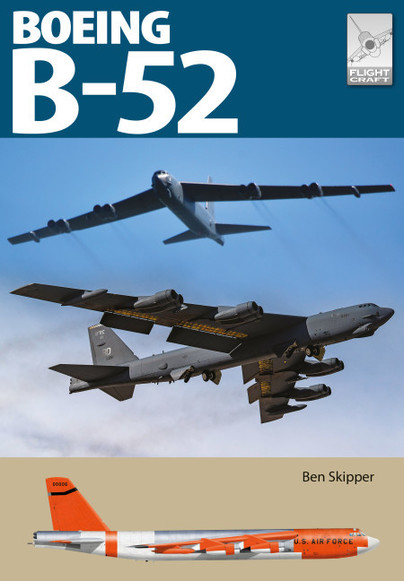Author Guest Post: Ben Skipper
There would have been no justice if I had left Boeing’s Fortress story incomplete and not gently pushed to write the history of the final ‘Fortress, the B-52 Stratofortress. On 15 April 1952, the B-52 made its first flight, a staggering 72 years ago and nearly 17 years after the B-17s first flight. With the design of the B-52, Boeing appeared to take the most successful elements, and more favourable experiences gleaned from its B-17, B29/B-50 and B-47 aircraft created something truly remarkable. Indeed, of the three Fortresses, the B-52 was the acme of the Very Heavy Bomber doctrine manifest.
Of the three books, the story of the B-52 has been the easiest to write; the mass of information available to draw research from is, as one would expect, almost exhausting. The USAF’s continued use of the B-52 as a combat platform is increasingly documented by photographs. In this wonderful age of social media, the amount of official and kindly shared enthusiast imagery has given me a remarkable insight into the B-52 and, more importantly, the people, military and civilian, who call the Big Ugly Fat Fella*(BUFF) their workplace and friend. The unintended longevity of the B-52 may well see it outlive aircraft such as the Rockwell B-1 Lancer as it takes on new avionics and mechanical changes with a phlegmatic ease that continues to defy belief. It is also a testament to the original Boeing team, who drew on a decade of bomber aircraft design experience to provide the fledgling USAF with an aeroplane that matched its expectations of what a Jet and Nuclear Age military aircraft was and could do. The B-52 could fly higher, farther and faster than any of its contemporaries, aiding its survivability.
Not only did the B-52 tower surpass its predecessors, but its development was led by lessons learned from combat and everyday operations for Boeing and the USAF. The B-47 Stratojet, of which over 2,000 airframes were built, had introduced Boeing to the era of the Turbo-jet and set them on the path to building another technologically advanced swept-wing nuclear-capable bomber aircraft. The B-47 also gave the United States Air Force (USAF) crews who flew and serviced it experience working with a large multi-engine aircraft. Sadly, the B-47 was hampered by its relatively short-range and mounting losses as crews struggled with ever-evolving doctrines that were rolled out from an indecisive Strategic Air Command (SAC). Then there were the inevitable mechanical stresses and strains on airframes that would hamper early Turbo-jet powered aircraft, adding to losses, often with the death of crews.
These early pioneering years of the Cold War and combat experience, especially from the Korean War (1950-1953), also helped commanders from Flight to Command level understand what they wanted from their aircraft. The need for a heavy bomber was still apparent, not only as a force multiplier but also as a political tool. They were led by General Curtiss LeMay (1906-1990), SAC soon formed plans to become not only an all Jet powered organization but also a 24-hour one, ready to come to answer any act of Warsaw Pact/Soviet Aggression, conventional or nuclear. LeMay had form for driving change, having done so with the B-29 forces of 20 and 21 Bomber Commands into an aerial vanguard par excellence.
LeMay had a knack for being able to keep one eye on the future, and for SAC, the B-47 was merely a stepping stone, a learning moment. A larger Boeing Very Heavy Bomber would supplant the Model 464 that was being prepared to replace the Convair B-36 Peacemaker. The B-36 was a ‘Just-in-case’ design that had been designed to defend the continental United States Eastern Flank should Europe fall under total Nazi Control in early 1941. In typical American bravado, Convair technical teams went to extremes, designing the largest production piston-driven aircraft ever seen. Thankfully the United Kingdom was able to maintain its unoccupied status and, in time, would be used as a convenient launch pad from which the Allies would conduct their 24-hour air war against the Nazis. With the increasing hostility between the Western Powers and the Soviet Union reaching its peak with the Berlin Airlift of 1948, the B-36 was the United States Army Air Force (USAAF/USAF) long-range Special Weapons (nuclear) carrier of choice. For all of its punch, the B-36 was very much yesterday’s aeroplane, and the Korean War would show that piston-powered bomber aircraft were easy targets for prowling North Korean and Chinese First Generation Turbo Jet powered Mig’s.
By now, Boeing had stepped up and was keen to press on with what would become an icon of the sky. Sleek, powerful and unmistakably a member of the ‘Fortress family, the aircraft that would become the B-52 would help shape the Cold War. Once in service, the B-52 would become LeMay’s baby, flown by the best pilots in the USAF. These select and elite ground and air crews would be given the best available from SAC, from accommodation to food the men and women, their families and civilian support staff would want for nothing; LeMay ensured that. In return, he demanded excellence in the air and on the ground. Professionalism was a way of life, not a contractual agreement. Boeing quickly bought into this ethos and began to work with and listen to the men and women of SAC who worked with the B-52, readily adopting changes and developing the aeroplane.
As the role of the B-52 changed from primary stand-by Special Weapon carrier to Very Heavy Bomber over the skies of Southeast Asia, it became apparent that Boeing had created a unique aeroplane. From large dumb Special Weapons such as the Mk39 nuclear bomb to the AGM-86 air-launched cruise missile (ALCM), the B-52 has overcome the teething problems associated with revolutionary aircraft to becoming the first combat aircraft to potentially completing a century of service as the J and K models are slowly brought on-line.
I sincerely hope I have given this icon the write-up it deserves. I hope my latest Flight Craft title will enthuse and ignite the imaginations of aviation history lovers and modellers alike.
*Fella can be interchanged with a perhaps far less complimentary term.

Order your copy here.

